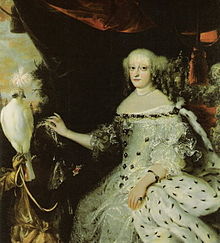Kammermohr
This article needs additional citations for verification. (March 2018) |


Kammermohr (or Hofmohr; pl. Kammermohren) was a German-speaking term since the 18th century for a court servant of black skin colour, which had by that time long been a common feature in European courts.[1]
History[]
People of black skin colour from the Orient, Africa and America have often been taken to Europe as valets during the time of Colonialism. This became common in the 16th-century and continued to be fashionable until the early 19th-century. The term Kammermohr was first used as an official term in a court protocol in 1747 in Saxon.
The splendidly decorated Kammermohr, often in livery, served a ruler, church dignitaries or wealthy merchants as an exotic object of prestige and as a status symbol, showcasing their wealth and luxury lifestyle. Above all, however, the valets symbolized the worldwide relations of their employer.
Notable examples[]
- Anton Wilhelm Amo, kammermohr of Anthony Ulrich, Duke of Brunswick-Wolfenbüttel.
- Adriaan de Bruin, kammermohr
- Angelo Soliman, kammermohr of Austrian Emperor Joseph II.
- Ignatius Fortuna, kammermohr of Countess Palatine Francisca Christina of Sulzbach
- Gustav Badin, kammermohr of first Queen Louisa Ulrika of Sweden and then Princess Sophia Albertine of Sweden.
- Abraham Petrovich Hannibal, kammermohr of Peter the Great
See also[]
- Chamberlain (office)
- Court dwarf
- Kizlar agha
References[]
- ^ Atlantic understandings: essays on European and American history in honor of Hermann Wellenreuther (in German). LIT Verlag. 2007. p. 88. ISBN 978-3825896072.
- Anti-black racism in Germany
- 18th century in Germany
- Courtiers